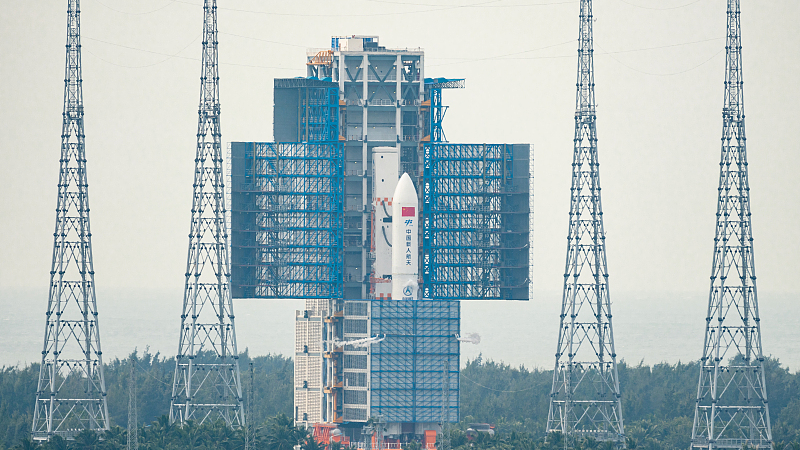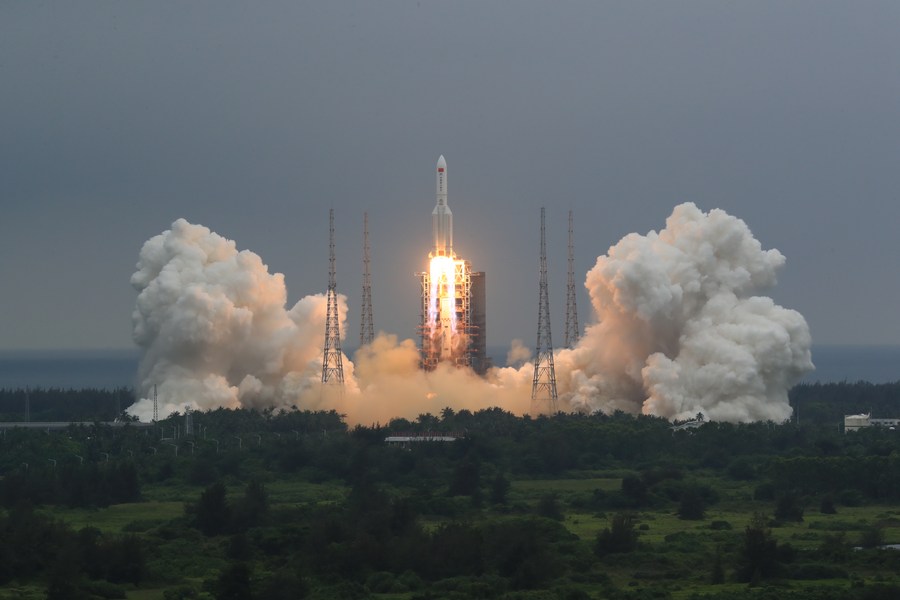
The space station lab module Mengtian ready to be launched from Wenchang Spacecraft Launch Site on the coast of south China's Hainan Province, October 31, 2022. /CFP
The space station lab module Mengtian ready to be launched from Wenchang Spacecraft Launch Site on the coast of south China's Hainan Province, October 31, 2022. /CFP
Editor's note: Yang Yuguang is vice chair of the Space Transportation Committee of the International Astronautical Federation. The article reflects the author's opinions and not necessarily the views of CGTN.
China's Tiangong is a "T-shaped" space station. In the initial phase, it is consisted of the Tianhe-1 core module, Wentian laboratory module and Mengtian laboratory module. With the launch of the space station lab module Mengtian on Monday afternoon from the Wenchang Spacecraft Launch Site on the coast of the southern island province of Hainan, the construction of Tiangong will be completed soon.
Just before the end of September, the Wentian Module was transferred from the front docking port of Tianhe-1 to its right-side berthing port, which freed the front docking port for Mengtian. This is an important but challenging step, since China has never tested the position transfer mechanism in orbit. A similar step will be conducted for Mengtian to take it to its final position. That can be recognized when Tiangong is constructed.
Like Wentian, the Mengtian laboratory module almost has the same size, with a length of 17.88 meters and maximum diameter 4.2 meters. It also has a pair of huge solar wings at its rear part, with a more than 55-meter wingspan. It has two-dimensional rotational mechanisms (Solar Array Drive Assembly, or SADA) to make the solar wings facing the sunlight always with the most ideal direction. This is an important feature of the Tiangong space station. Although Tiangong adopted a modular design, which is similar to the MIR space station, the third generation among all manned space stations. But Tiangong belongs to the fourth generation. The reason lies on the design of the Wentian and Mengtian. Although Tiangong does not have an International Space Station (ISS)-like truss structure, the fuselages of the Wentian and Mengtian have similar functions of this truss. By mounting the huge solar wings at the tale of each module, it can also avoid any module blocking the sunlight. Therefore, the Tiangong space station has a power output more than 6750W, which meets scientific research' requirements.
Each of the solar wings on Mengtian is larger than 110 square meters; the solar cells are made of triple junction gallium arsenide. The efficiency of this kind of solar cells is greater than 30 percent. In the future, the China Manned Space Agency plans to move the solar wings of Tianhe-1 to the rear part of Wentian. At that moment, the sunlight condition will be further optimized. Although the size of the Tiangong space station is smaller than the ISS, but with the above measures, the electricity dedicated for scientific research will be at the same level.

The Long March-5B Y2 rocket, carrying the Tianhe module, blasts off from Wenchang Spacecraft Launch Site in south China's Hainan Province, April 29, 2021. /Xinhua
The Long March-5B Y2 rocket, carrying the Tianhe module, blasts off from Wenchang Spacecraft Launch Site in south China's Hainan Province, April 29, 2021. /Xinhua
Besides scientific research, the Wentian has to act as the backup of many critical functions of the Tianhe-1 core module. For instance, the regenerative environmental control and life support system, the control moment gyroscopes for attitude control, etc. It also has three sleeping chambers for astronauts during turn over of different expedition teams. But the Mengtian module does not have these kinds of functions, and Mengtian has more space for standard racks dedicated for scientific research. It has space fore 13 racks, greater than the sum of those in the Tianhe-1 and Wentian module. 10 of the 13 racks will be launched together with Mengtian. To some extent, Mengtian is the most important module of Tiangong for scientific research.
According to information released by the China Manned Space Agency, Mengtian will be engaged mainly in microgravity physics. The phenomena related to liquid flow, combustion in microgravity environment will be studied in this module. Some special material can also be made in this module. We can see these tasks as the rudiment of space-based manufacturing. If we can reduce transportation costs between space and the ground, the needs of manufacturing in orbit will rise and a new industry may appear. The human being has prepared for this day in many decades. The scientific research on atomic clocks will not only improve the accuracy of China's future navigation satellites, but will benefit spaceborne scientific studies in many fields.
Moreover, Mengtian is also equipped with an unmanned cargo airlock. Not like the main airlock in the Wentian module for extravehicular activity (EVA) of astronauts, this airlock will be used to transfer objects of up to 400kg between the cabin and outer space. The astronauts' EVA is high-risk, and the designed lifespan of the Feitian spacesuit is only 15 times. Therefore, EVA will be conducted only when it is necessary. But the need to transfer something between the cabin and outer space always exists. In this circumstance, the cargo airlock will be very useful. Without going out of the station, the astronauts may bring something inside this airlock, close the rear hatch, unpressurize airlock and open the front hatch. Then with the help of a robotic arm, the object inside the airlock can be brought to outer space. The opposite operations are similar. The design of this unmanned airlock can reduce the astronauts' burdens to the greatest extent. More scientific actions can be conducted in outer space. They can even release CubeSats via this airlock.
China will also launch another module called the Xuntian, which is recognized as "China's Hubble Space Telescope." But not like other modules, it will fly independently. Only when it needs some maintenance or upgrades, it will rendezvous and dock with Tiangong. This is an optimized design on a system level, which makes the Xuntian's maintenance much easier and cheaper than that of the Hubble.
(If you want to contribute and have specific expertise, please contact us at opinions@cgtn.com. Follow @thouse_opinions on Twitter to discover the latest commentaries in the CGTN Opinion Section.)